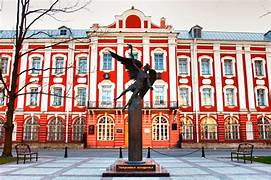Saint Petersburg State University

About
aint Petersburg State University (SPBGU; Russian: Санкт-Петербургский государственный университет) is a public research university in Saint Petersburg, Russia, and one of the oldest and most prestigious universities in Russia. Founded in 1724 by a decree of Peter the Great, the university from the beginning has had a focus on fundamental research in science, engineering and humanities.
During the Soviet period, it was known as Leningrad State University (Russian: Ленинградский государственный университет). It was renamed after Andrei Zhdanov in 1948 and was officially called "Leningrad State University, named after A. A. Zhdanov and decorated with the Order of Lenin and the Order of the Red Banner of Labour." Zhdanov's was removed in 1989 and Leningrad in the name was officially replaced with Saint Petersburg in 1992.[4]
It is made up of 24 specialized faculties (departments) and institutes, the Academic Gymnasium, the Medical College, the College of Physical Culture and Sports, Economics and Technology. The university has two primary campuses: one on Vasilievsky Island and the other one in Peterhof.
- The specialist's programme "General Medicine" includes a wide range of disciplines to train medical doctors. Particular attention is paid to the teaching of fundamental disciplines in junior courses, which develops wide scientific horizons among students. Lecturers from different faculties of the University are involved in the training process. In senior years, students study clinical disciplines. To master their professional skills, students have practical training in: a well-equipped simulation centre of St Petersburg University; and leading medical institutions and healthcare centres. Practical training is the key component in the training of healthcare personnel. As part of their practical classes and summer internships, students therefore participate in the diagnosis of diseases and the treatment of patients under the supervision of experienced professionals. Within the framework of the "General Medicine" programme, clinical practice is combined with research activities under the supervision of the academic staff of St Petersburg University
- The programme "General Medicine" is unique in that it provides students with an opportunity to develop their professional skills set of a doctor and approaches to advanced scientific research. Graduates of the programme are ready to use cutting-edge methods and technologies, including digital ones, based on the latest scientific achievements in the field of medicine
A medical school is a tertiary educational institution, professional school, or forms a part of such an institution, that teaches medicine, and awards a professional degree for physicians. Such medical degrees include the Bachelor of Medicine, Bachelor of Surgery (MBBS, MBChB, MBBCh, BMBS), Master of Medicine (MM, MMed), Doctor of Medicine (MD), or Doctor of Osteopathic Medicine (DO). Many medical schools offer additional degrees, such as a Doctor of Philosophy (PhD), master's degree (MSc) or other post-secondary education.
Medical schools can also carry out medical research and operate teaching hospitals. Around the world, criteria, structure, teaching methodology, and nature of medical programs offered at medical schools vary considerably. Medical schools are often highly competitive, using standardized entrance examinations, as well as grade point averages and leadership roles, to narrow the selection criteria for candidates. In most countries, the study of medicine is completed as an undergraduate degree not requiring prerequisite undergraduate coursework. However, an increasing number of places are emerging for graduate entrants who have completed an undergraduate degree including some required courses. In the United States and Canada, almost all medical degrees are second-entry degrees, and require several years of previous study at the university level.
Medical degrees are awarded to medical students after the completion of their degree program, which typically lasts five or more years for the undergraduate model and four years for the graduate model. Many modern medical schools integrate clinical education with basic sciences from the beginning of the curriculum (e.g.[1][2]). More traditional curricula are usually divided into preclinical and clinical blocks. In preclinical sciences, students study subjects such as biochemistry, genetics, pharmacology, pathology, anatomy, physiology and medical microbiology, among others. Subsequent clinical rotations usually include internal medicine, general surgery, pediatrics, psychiatry, and obstetrics and gynecology, among others.
Although medical schools confer upon graduates a medical degree, a physician typically may not legally practice medicine until licensed by the local government authority.[3] Licensing may also require passing a test, undergoing a criminal background check, checking references, paying a fee, and undergoing several years of postgraduate training. Medical schools are regulated by each country and appear in the World Directory of Medical Schools which was formed by the merger of the AVICENNA Directory for Medicine and the FAIMER International Medical Education Directory.

